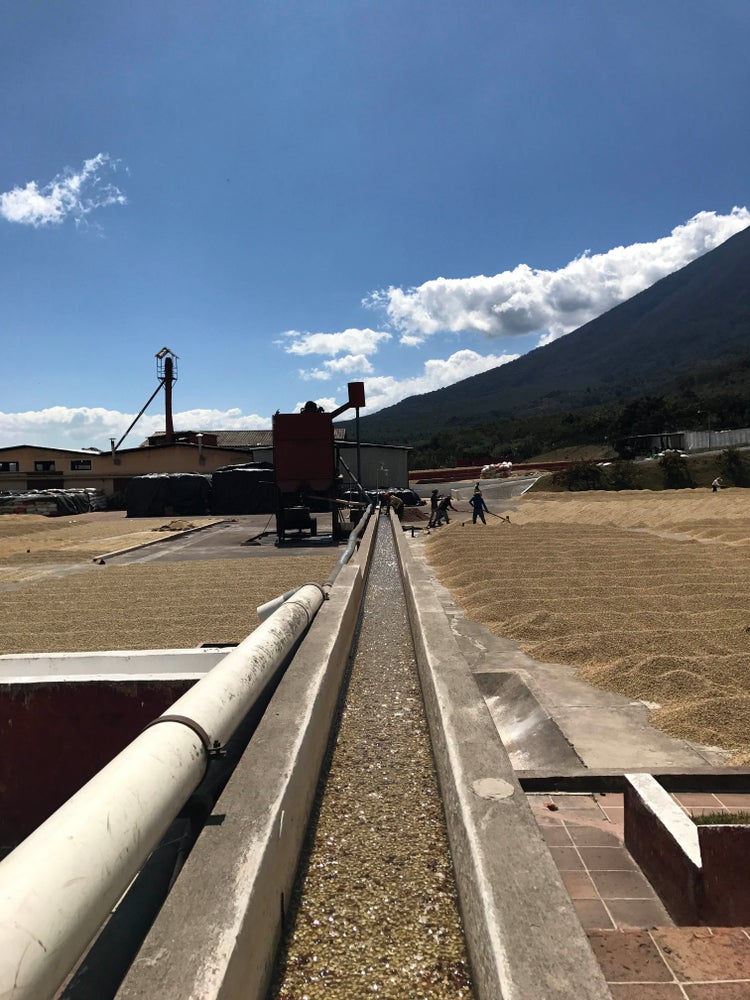About This Coffee
Spanning five communities in the San Juan del Rio Coco region in Northern Nicaragua, UCA SJRC, helps farmers produce profitable and environmentally responsible coffee.
UCA SJRC is a union of 8 cooperatives in the region that represent more than 370 small producers. The 8 separate cooperatives in the region joined together in 1993 to be able to better help their members better control coffee quality and access better prices. The region and the cooperative are both named after the Rio Coco, a large river that runs through the region. As agrarian communities, the Rio Coco remains a source of an essential element of survival: water.
Harvest & Post-Harvest
Cherry is selectively handpicked. Since most farmers have small plots of land—about 2.8 hectares on average—most of the labor on the farm is completed by family members. However, at the peak of the harvest, the family may hire a few extra hands to help them pick cherry at its ripest.
After harvest, farmers float cherry to remove any underripes or lights that may have been accidentally picked and conduct a visual inspection to remove any cherry that has insect damage or other visible defects. Cherry is then pulped and fermented. About half of UCA SJRC members have their own wet mill. These members can also earn extra income by renting their mills to neighbors who do not own their own set up.
After fermentation, farmers and their families inspect wet parchment a second time for any visual defects. As they inspect it, the wet parchment begins the first stages of drying.
The humid climate of the coffee regions makes it difficult to dry parchment well. Instead, farmers bring their wet parchment down to the town of San Juan del Rio Coco, where UCA SJRC has its own drying and quality control facilities. When farmers deliver their wet parchment, higher prices incentivize them to deliver parchment that is clean of any defects and at the proper moisture content.
The UCA SJRC facility conducts the final drying on a large patio. Lots are kept traceable with tags that detail which sub-cooperative delivered the coffee. After drying dried parchment is placed in bags that identify the quality and source of the coffee and is stored in the warehouse.
When parchment is fully dried, the UCA SJRC quality team cups the lots. Since some defects, such as mold or phenol, might not be visible until the first cupping, the cooperative maintains the right to reject any parchment they’ve purchased until they cup it. This way, the cooperative sells only the highest quality lots. After a resting period, the quality team recups the coffees and decides on the proper quality category for each coffee.
SHG
Strictly High Grown (SHG) specifies the altitude at which the coffee was grown. A coffee must be grown at 1,200 meters above sea level or higher to be considered SHG. The higher altitude and lower temperatures mean that the coffee fruit matures more slowly, creating a denser bean.
European Preparation (EP)
EP stands for European Preparation. EP beans are Screen 15+ with a low defect tolerance.
Coffee in Nicaragua
Nicaragua may not be the most famous producer of Central American coffee, but it has great potential. The country is known as the land of ‘los lagos y los volcanes’ (lakes and volcanos) and has many coffee growing ‘pockets’ that few have heard of or experienced. Many producers in the country are experimenting with new varieties and processing methods, making it a specialty origin to watch.
Many coffee producers in Nicaragua today are buoyed by cooperatives that provide a wide array of services, supports and opportunity. As seen in the win of the ‘El Acuerdo de las Tunas’, where 3,000 landless workers won land rights, collective action by farmers can be far more effective at enacting widespread change than the advocacy of individual farmers.
Cooperatives and farmer associations in Nicaragua encompass a large percentage of the country’s coffee producers, and they are taking their destiny in their own hands. By putting great emphasis on quality and by aiming for the international specialty coffee industry, cooperatives and farmers associations are helping their members gain influence and import that will, hopefully, garner enough profit to enable farmers to continue to improve and invest in their farms and their families.
Large and medium-sized (10+ hectare) farms also hold a significant place in Nicaragua’s coffee landscape, as well. Many of these farms have also prioritized social and environmental issues and are working on quality improvements at both cultivation and post-harvest levels.
Farmers, for the most part, will process coffee on their own farms, and the majority of the time coffee is dried on large drying patios under sun.

